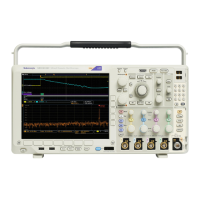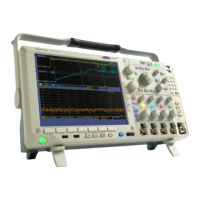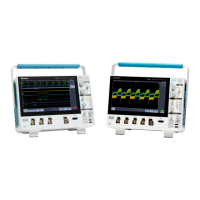Commands Listed in Alphabetical Order
channel that ha
s no probe attached or a probe that does not support DCREJect
coupling attached results in a settings conflict error event and the coupling
remains unchanged.
Examples
CH2:COUPLING AC sets channel 2 to AC coupling.
CH3:COUPling? might return :CH3:COUPling DC indicating that channel 3
is set to DC coupling.
CH<x>:DESKew
This command specifies the deskew time for channel <x>, where x is the
channel number (1–4). You can adjust the deskew time to add an independent,
channel-based delay time to the delay (set by the horizontal position control and
common to all channels) from the common trigger point to first sample taken for
each channel. This lets you compensate individual channels for different delays
introduced by their individual input hook ups.
Group
Vertical
Syntax
CH<x>:DESKew <NR3>
CH<x>:DESKew?
Arguments
<NR3> is a floating point number that specifies the deskew time for channel <x>,
ranging from -100 ns to +100 ns with a resolution of 1 ps.
Examples
CH4:DESKew 5.0E-9 sets the deskew time for channel 4 to 5 ns.
CH2:DESKew? might return :CH2:DESKEW 2.0000E-09 ind
icating that the
deskew time for channel 2 is set to 2 ns.
CH<x>:INVert
This command specifies the invert function for channel <x>, where is the channel
number (1–4) . When on, the invert function inverts the waveform for the
specified channel.
NOTE. This command inverts the waveform for display purposes only. The
oscilloscope does not use an inverted waveform for triggers or trigger logic inputs.
Group
Vertical
2-222 MDO4000/B/C, MSO/DPO4000B and MDO3000 Series Oscilloscopes Programmer Manual

